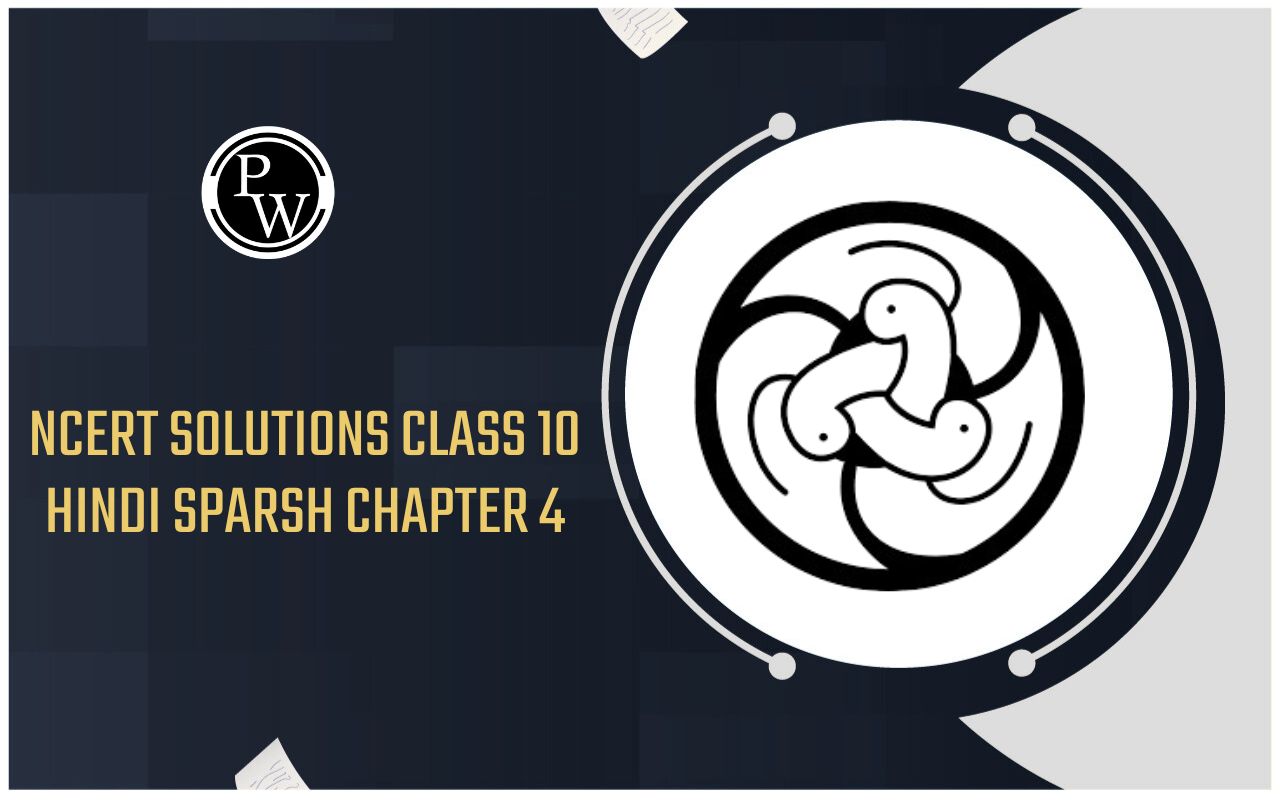
NUCLEUS
Cell of Class 9
NUCLEUS
- The nucleus is a small, round and membrane-bound structure found in cells.
- And the fluid inside the nucleus surrounded by the nuclear membrane is called nucleoplasm.
- It controls cell's growth and reproduction as it contains cell's hereditary information.
- It's covered by dual layer called a nuclear membrane.
- It's the most important part of the cell which controls and regulate all the vital activities of the cell .
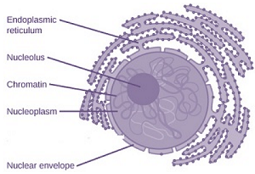
Robert Brown (1881) discovered the nucleus.
J. Hammerling (1953) proved the hereditary role of the nucleus on a green alga Acetabularia
- Distribution : Present in all eukaryotic cells. In certain cells, they get disintegrated when cells attain maturity e.g., RBC in mammals, no true nucleus is present in prokaryotes.
- Number : Generally a cell contains a single nucleus i.e., mononucleated condition, sometimes certain cells show binucleated or multinucleated conditions
- Shape : The shape of the nucleus is variable and the shape depends on the functional state of cell. The shape may be discoid in case of flattened squamous epithelium cells, spherical, cuboidal or polyhedral cells, ovoid in columnar cells, bilobed or multilobed in leucocytes.
Position of nucleus
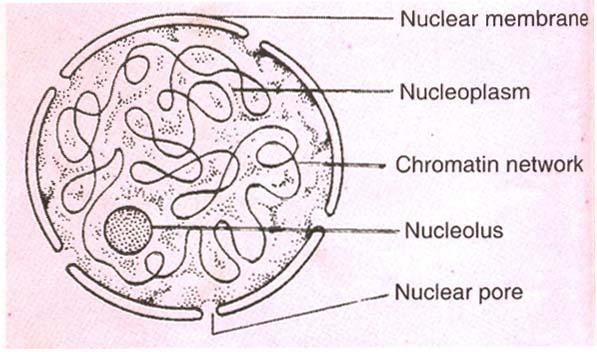
Structure of a nucleus
Nucleus has the following important parts:
- Nuclear membrane
- Nucleoplasm
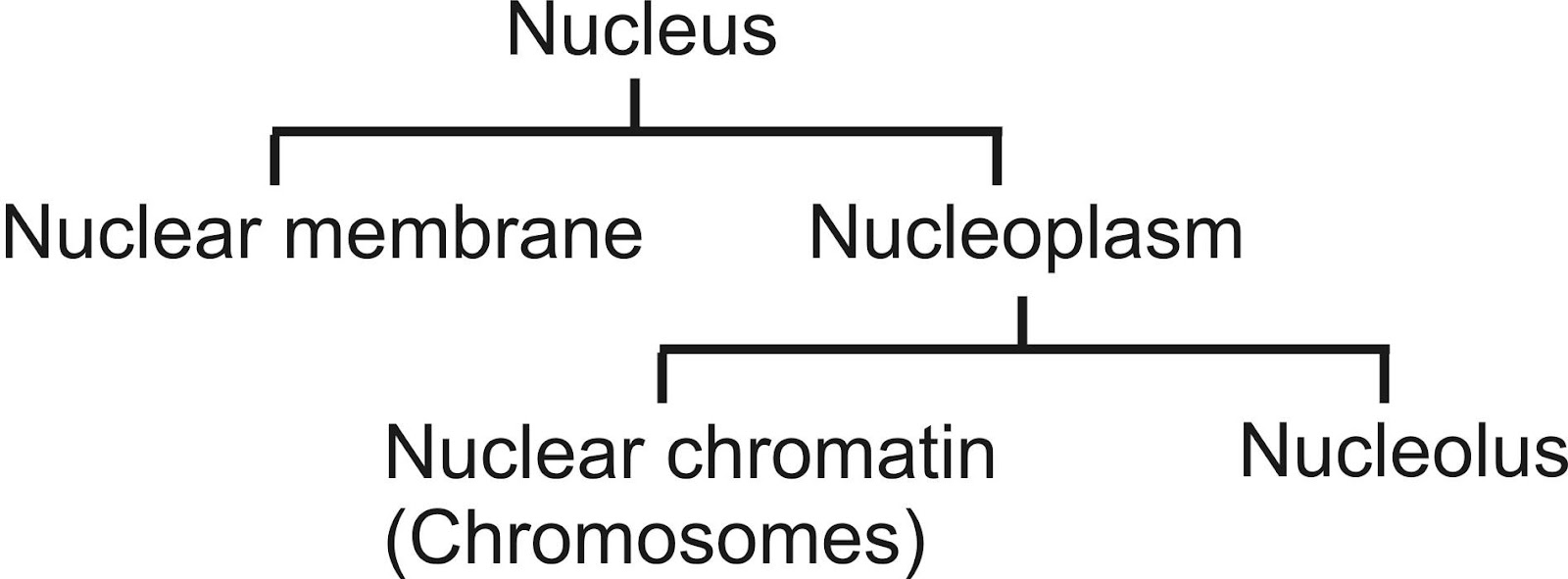
Flow chart of Nucleus showing its constituents
Nuclear Membrane
- The nucleus is bounded by a double membrane structure called nuclear envelope or karyotheca.
- Nuclear membrane is semi-permeable and helps in the exchange of dissolved matter between protoplasm and nucleus while nuclear pores are the pathway for the exchange of micromolecules.
- It is a thin double membrane surrounding the nucleus.Each membrane is 90 Å thick and both are separated by a 120-300 Å, this space is known as perinuclear space. It contain many small nuclear pores of 400 Å diameter. They are surrounded by a thin membrane and protoplasmic Annulus.
- Inside the nucleus, a clear or slightly acidophilic mass is present, which is called karyoplasm or nuclear sap.
Nucleoplasm
- It is transparent, homogeneous and granular dense fluid. It possesses high quantities of phosphorous and proteins.
- Many thread like structures are irregularly present in nucleoplasm. Their shape changes during cell division.
It has following structures in it :
- Nuclear chromatin
- Nucleolus
Nuclear chromatin or chromatin material
- The nucleoplasm contains many thread like, coiled and much elongated structures known as Nuclear reticulum and is made up of chromatin, it is also known as chromatin net.
-
These thread like structures contain small granular bodies known as chromomeres. At the time of cell division chromatin net thickens and distinguishes into rod like structures known as chromosomes.
- Each chromosome remains in the form of chromatin network but actually consists of two parts known as Hetero-chromatin and Euchromatin.
- It is made up of two chromonemata and each chromonemata thread contain numerous small button shaped particles known as genes.
- They are made up of DNA and help in the transfer of heredity characters from one generation to another.
| Cells | Position |
| Embryonic cells | Central position |
| Adipose tissue | Peripheral position |
| Glandular cells | Basal position |
| Mature plant cell | Peripheral etc. |
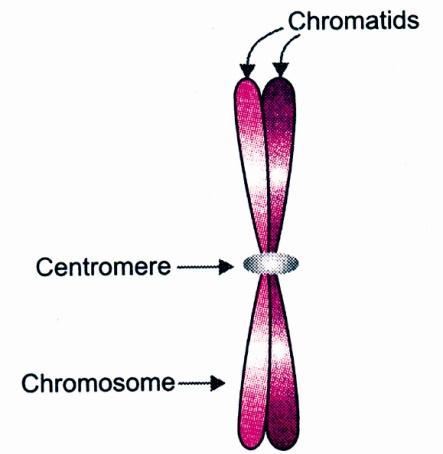
Nucleolus
- The nucleus contains a large, spherical, dense, granular, and stable structure known as nucleolus.
- These are one or more round structures that are not bound by a membrane.
- They are rich in RNA and proteins.
- It is known as factory of ribosomes.
Functions of Nucleus
- Control centre : It controls all the metabolic activities of the cell. If it is removed the protoplasm dries up and dies.
- Genetic information : It is responsible for the transmission of hereditary traits.
- It regulates cell cycle.
- Ribosomes are formed by nucleolar part of nucleus.
-
Nucleus plays a central role in cellular reproduction (process by which single cell divides to form two new cells).
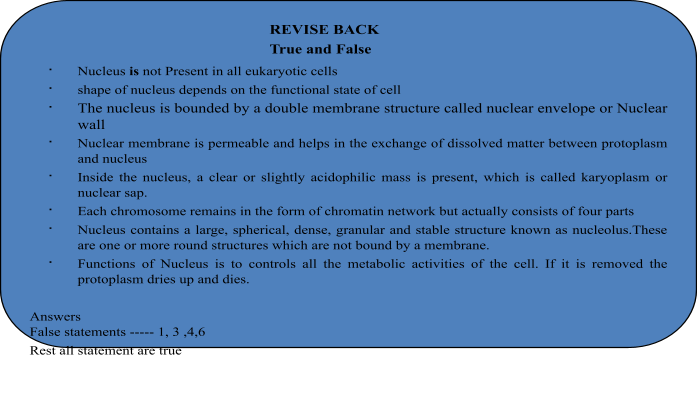
🔥 Trending Blogs
Talk to a counsellorHave doubts? Our support team will be happy to assist you!

Free Learning Resources
PW Books
Notes (Class 10-12)
PW Study Materials
Notes (Class 6-9)
Ncert Solutions
Govt Exams
Class 6th to 12th Online Courses
Govt Job Exams Courses
UPSC Coaching
Defence Exam Coaching
Gate Exam Coaching
Other Exams
Know about Physics Wallah
Physics Wallah is an Indian edtech platform that provides accessible & comprehensive learning experiences to students from Class 6th to postgraduate level. We also provide extensive NCERT solutions, sample paper, NEET, JEE Mains, BITSAT previous year papers & more such resources to students. Physics Wallah also caters to over 3.5 million registered students and over 78 lakh+ Youtube subscribers with 4.8 rating on its app.
We Stand Out because
We provide students with intensive courses with India’s qualified & experienced faculties & mentors. PW strives to make the learning experience comprehensive and accessible for students of all sections of society. We believe in empowering every single student who couldn't dream of a good career in engineering and medical field earlier.
Our Key Focus Areas
Physics Wallah's main focus is to make the learning experience as economical as possible for all students. With our affordable courses like Lakshya, Udaan and Arjuna and many others, we have been able to provide a platform for lakhs of aspirants. From providing Chemistry, Maths, Physics formula to giving e-books of eminent authors like RD Sharma, RS Aggarwal and Lakhmir Singh, PW focuses on every single student's need for preparation.
What Makes Us Different
Physics Wallah strives to develop a comprehensive pedagogical structure for students, where they get a state-of-the-art learning experience with study material and resources. Apart from catering students preparing for JEE Mains and NEET, PW also provides study material for each state board like Uttar Pradesh, Bihar, and others
Copyright © 2025 Physicswallah Limited All rights reserved.
Get App


